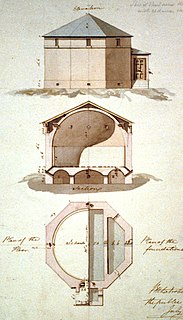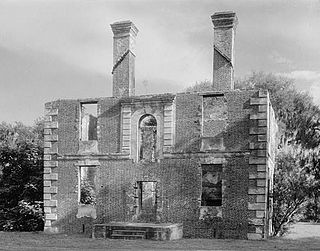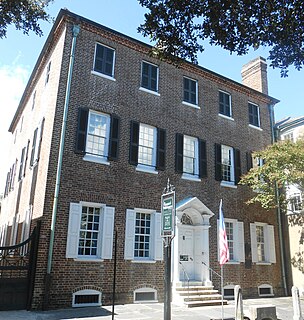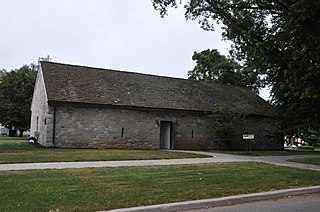
The Nathaniel Russell House is a historic house at 51 Meeting Street in Charleston, South Carolina, United States. Built by slave trader and wealthy merchant Nathaniel Russell in 1808, it is recognized as one of America's most important Neoclassical houses. It was designated a National Historic Landmark in 1973.

The William Gibbes House is a historic house at 64 South Battery in Charleston, South Carolina. Built about 1772, it is one of the nation's finest examples of classical Georgian architecture. It was declared a National Historic Landmark in 1970.

The Fireproof Building, also known as the County Records Building, is located at 100 Meeting Street, at the northwest corner of Washington Square, in Charleston, South Carolina. Completed in 1827, it was the most fire-resistant building in America at the time, and is believed to be the oldest fire-resistant building in America today.

A gunpowder magazine is a magazine (building) designed to store the explosive gunpowder in wooden barrels for safety. Gunpowder, until superseded, was a universal explosive used in the military and for civil engineering: both applications required storage magazines. Most magazines were purely functional and tended to be in remote and secure locations. They are the successor to the earlier powder towers and powder houses.

The Robert Brewton House is a historic house at 71 Church Street in Charleston, South Carolina. With a construction date at or before 1730, it is the oldest dated example of a "single" house. A single house is one room wide, with the narrow end towards the street, the better to catch cool breezes. It was declared a National Historic Landmark in 1960.

The Paul Hamilton House, commonly referred to as the Brick House Ruins, is the ruin of a 1725 plantation house on Edisto Island, South Carolina, that burned in 1929. It was designated a National Historic Landmark in 1970 for the unusual architecture of the surviving walls, which is partly based on French Huguenot architecture of the period.

The Market House is an unusual combination town hall, town market building, and town focal point, in the very heart of Fayetteville, Cumberland County, North Carolina. It was built in 1838 on a site previously occupied, until it burned in 1831, by the old state house, or Old Town Hall; Fayetteville was capital of North Carolina from 1789 to 1794. It has an arcaded open ground level, and a meeting hall above, a form believed to be unique in the United States, but with precedents in England. It served both functions until the early 20th century, and was declared a National Historic Landmark in 1973. The upper floor now houses a museum.

St. James Church, Santee, also known as St. James Episcopal Church, Santee, is a historic church located in a remote portion of Francis Marion National Forest in Charleston County, South Carolina. Built in 1768, it is a remarkably sophisticated expression of fashionable Georgian architecture in a remote area, and was designated a National Historic Landmark in 1970 for its architectural significance. It is located on the west side of the Old Georgetown Road, several miles north of South Carolina Highway 46 and McClellanville.

St. James' Church, Goose Creek, also known as the Goose Creek Church, is an Episcopal church at 100 Vestry Lane in Goose Creek, South Carolina. Built in the 1710s, it is one of South Carolina's oldest surviving buildings, and one of a small number of surviving early Georgian chapels in the nation. It was declared a National Historic Landmark in 1970.

The Heyward-Washington House is a historic house museum at 87 Church Street in Charleston, South Carolina. Built in 1772, it was home to Thomas Heyward, Jr., a signer of the United States Declaration of Independence, and was where George Washington stayed during his 1791 visit to the city. It is now owned and operated by the Charleston Museum. Furnished for the late 18th century, the house includes a collection of Charleston-made furniture. Other structures include the carriage shed and 1740s kitchen building.

The Old Exchange & Provost Dungeon, also known as the Custom House, and The Exchange, is a historic building at East Bay and Broad Streets in Charleston, South Carolina, USA. Built in 1767–1771, it has served a variety of civic institutional functions, including notably as a prisoner of war facility operated by British forces during the American Revolutionary War. The building was designated a National Historic Landmark in 1973. It is now a museum operated by the Daughters of the American Revolution.

The Charleston Historic District, alternatively known as Charleston Old and Historic District, is a National Historic Landmark District in Charleston, South Carolina. The district, which covers most of the historic peninsular heart of the city, contains an unparalleled collection of 18th and 19th-century architecture, including many distinctive Charleston "single houses". It was declared a National Historic Landmark in 1960.

St. Michael's Episcopal Church is a historic church and the oldest surviving religious structure in Charleston, South Carolina. It is located at Broad and Meeting streets on one of the Four Corners of Law, and represents ecclesiastical law. It was built in the 1750s by order of the South Carolina Assembly. It is listed on the National Register of Historic Places and is a National Historic Landmark.

The Colonel John Stuart House is a historic house at 104-106 Tradd Street in Charleston, South Carolina. Built in 1772, four years before the American Revolution, it is the city's oldest known example of a side-hall plan house. It is nationally significant as the home of Colonel John Stuart, who was the King's Superintendent of Indian Affairs in the South. He improved relations with the Five Civilized Tribes, especially the Cherokee Nation between the Seven Years' War and the American Revolutionary War. It was declared a National Historic Landmark in 1973.

The Old Marine Hospital is a historic medical building at 20 Franklin Street in Charleston, South Carolina. Built 1831-33 to a design by Robert Mills, it was designated a National Historic Landmark in 1973 for its association with Mills, and as a high-quality example of Gothic Revival architecture. The hospital was built as a public facility for the treatment of sick sailors and other transient persons.

St. Philip's Church is an historic church at 142 Church Street in Charleston, South Carolina. Its National Historic Landmark description states: "Built in 1836, this stuccoed brick church features an imposing tower designed in the Wren-Gibbs tradition. Three Tuscan pedimented porticoes contribute to this design to make a building of the highest quality and sophistication." On November 7, 1973, it was added to the National Register of Historic Places and designated a National Historic Landmark.
Powder Magazine, Powder House, or Powderworks may refer to:

The Circular Congregational Church is a historic church at 150 Meeting Street in Charleston, South Carolina, United States, used by a congregation established in 1681. Its parish house, the Parish House of the Circular Congregational Church, is a highly significant Greek Revival architectural work by Robert Mills, and is recognized as a U.S. National Historic Landmark.

The U.S. Post Office and Courthouse is a historic post office and courthouse located at Charleston in Charleston County, South Carolina. The building and its annexes serve the federal court for the Charleston Division of the United States District Court for the District of South Carolina. The building was listed on the National Register of Historic Places in 1974.

Hessian Powder Magazine, also known as the Hessian Guardhouse Museum, is a historic guardhouse and gunpowder magazine located on the grounds of Carlisle Barracks at Carlisle, Cumberland County, Pennsylvania. It was built in 1777, and is a stone walled structure, lined with interior brick. It measures 70 feet by 32 feet and the walls are 4 1/2-feet thick. It has a vaulted stone roof, covered by timbers and tin to take a gable form. Tradition says that some Hessian Prisoners of war, captured at the Battle of Trenton were sent to Carlisle. They were used to build this guard house, originally a magazine. It was probably first used as a guardhouse in the 1870s and when included as part of the Carlisle Indian Industrial School (1879–1918). Afterwards, it was used as a quartermaster and medical supply storehouse, filmstrip laboratory, message center, and U.S. post office. It was designated a museum in 1948.























